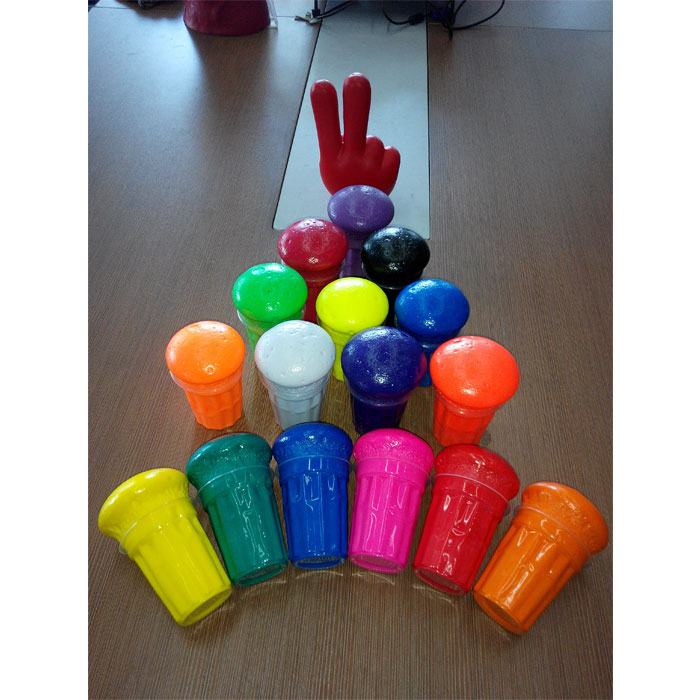Poliuretán elastomer formed by the polymerization reaction of diisocyanate and active hydrogen compound, the rigid segment containing urea group composed of diisocyanate and diamine chain extender, the glass transition temperature is much higher than room temperature, and it is glassy at room temperature. Subcrystals or microcrystals form the plastic phase; flexible segments of polyether or polyester are gathered together to form the matrix or matrix of the poliuretán rubber. Because its glass transition temperature is lower than room temperature, it is called the rubber phase. The microphase separation of the poliuretán elastomer makes the poliuretán elastomer have the advantages of good wear resistance, wide range of hardness, high strength and high elongation, large load supporting capacity, good shock absorption effect and excellent oil resistance. Choosing a suitable molding and processing method can maximize the performance of poliuretán elastomers and prepare various poliuretán elastomers with excellent properties, which are widely used as plastics, rubber, fibers, adhesives and coatings, and even as functional polymer materials. Such as medical poliuretánanyagok.
1.1 A formázó feldolgozási módszerek kiválasztásának általános elvei
(1) Az öntési eljárás általában egy polimer vegyület szilárd vagy por alakú (por vagy szemcsés), paszta vagy oldat állapotú olvadását vagy deformálását jelenti, és a kívánt formát egy öntőformán keresztül alakítja ki, és megőrzi a kapott alakot, végül pedig a termék. kézműves folyamat.
(2) Közös formázási folyamat: „A módszer a polimer vegyületkeverék egyszeri és kétszeri előállítására termékek előállításához; „A polimer vegyület előállításának módja termékek előállítására egyszerre; â ‘¢ A monomerkeverékbôl termékek egy lépésben történô elôállításának módja â‘ £ Az oligomer keverék egylépéses elôállítási módja.
(3) Feldolgozási teljesítmény és befolyásoló tényezői: „Összenyomhatóság, az extruderben, az injekciós gép hordójában, a kalander görgőiben és a szerszámban, amikor az anyagot extrudálással deformálják, az anyag alakját kapjuk és megőrizte képességét. Korlátozó tényezői: az olvadék viszkozitása, a feldolgozó berendezés szerkezete, az olvadék reológiája és az olvadék áramlási sebessége. "Hajlíthatóság, a fröccsöntési folyamat során a fröccsöntőgép, az extruder és a préselőgép hatására az anyag deformálódik a hőmérséklet és a nyomás hatására, valamint a formába önthető képesség hatására. Korlátozó tényezői: reológia, termikus tulajdonságok és egyéb fizikai és mechanikai tulajdonságok, valamint a polimer vegyületek kémiai reaktivitása. • Kiterjeszthetőség, kalanderezés vagy nyújtás során az anyag deformálódik kalanderezéssel vagy egy vagy két irányban történő nyújtással. Korlátozó tényezői: az anyag plaszticitása és a húzáskeményítő hatás. - Forgathatóság, a fúvóka az extrudálás során, az anyag azon képessége, hogy folyamatos szilárd szálakat képezzen az öntés során. Korlátozó tényezői: reológia, olvadék viszkozitás és szilárdság, termikus stabilitás és kémiai stabilitás.
1.2 A formázási és feldolgozási módszerek kiválasztásának általános elveipoliuretánelasztomerek
Poliuretán elastomer molding processing system is divided into liquid system and solid system. On the basis of the rapid polymerization reaction of diisocyanate and active hydrogen compound, the molding processing method is conducive to the microphase separation of the poliuretán elastomer. , Liquid system, poliuretán casting glue can be processed by casting (manual casting, centrifugal casting and vacuum casting), reaction injection molding, spraying, knife coating, roller coating, laminating, laminating, bonding, vulcanizing, pasting and rubbing ; Solid system, poliuretán compound rubber can be vulcanized and laminated with mold, poliuretán thermoplastic can be used with thermoplastic, hot injection, calendering, blow molding, spinning and lamination.
1.3 Az alaptípusok és a fröccsöntési eljárások illesztési elve
PoliuretánAz elasztomer modulárisan magas polimer a műanyag és a gumi között. Főként magában foglaljapoliuretán compound rubber, poliuretán cast rubber, poliuretán water emulsion and poliuretán thermoplastic. Poliuretán leather, poliuretán adhesives, poliuretán coatings, poliuretán compounds, poliuretán casting glues, poliuretán fibers, poliuretán water emulsions and poliuretán thermoplastics are all derived from the above four types of glue. The molding and processing methods of poliuretán compound rubber, poliuretán water emulsion and poliuretán thermoplastic generally belong to the molding processing methods of rubber, coatings and plastics.
1.4 The use of poliuretán elastomers and the matching principle of production continuity and molding processing methods
Poliuretán elastomer molding and processing methods are matched with the use of poliuretán elastomers, taking into account the continuity of production. For example, poliuretán leather molding methods usually use poliuretán casting adhesive or foaming layer, poliuretán water emulsion and poliuretán thermoplastic as the surface layer; also available Poliuretán thermoplastic and poliuretán water emulsion are used as leather separately, which are based on the basic rubber molding processing method, supplemented by foam molding processing, usually calender molding processing method is selected. Poliuretán paving materials are made of poliuretán casting glue, mainly due to the large product shape and low precision requirements. Medical poliuretán materials have good chemical stability, tissue compatibility, and resistance to biological aging, so the molding process uses dip coating, pouring and coating methods.


